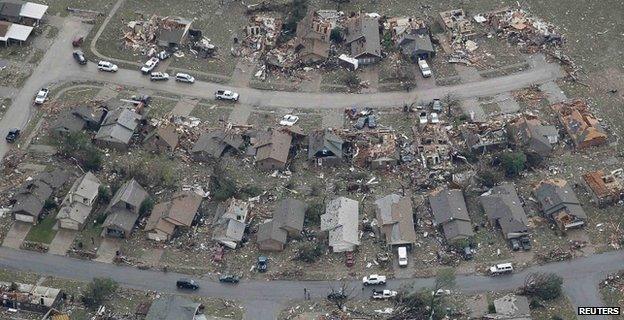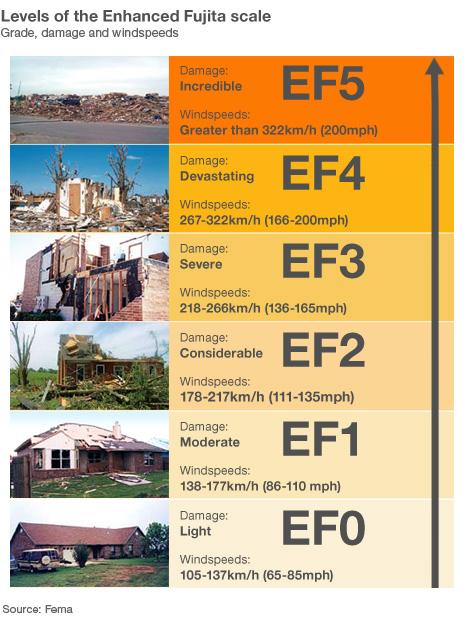Just how bad is an EF5 tornado?
- Published

The EF rating of a tornado is based solely on the damage it has caused
On Tuesday, officials at the US National Weather Service (NWS) upgraded the intensity of Monday's tornado in Moore, Oklahoma from its preliminary estimate of EF4 to EF5 - the top of the scale. But what does that mean?
At its simplest, the highest level of the "Enhanced Fujita scale" indicates the highest wind speeds - greater than 320 km/h (200mph).
Unlike the rest of the scale, EF5 has no upper limit. The NWS report, external suggests estimated peak winds just into the EF5 regime - far lower than another EF5 that hit the very same town in 1999, external - estimates of which put the winds in excess of 500km/h (300mph).
An EF5 represents the most violent tornadoes we have ever seen - and will ever see. Monday's event was just the 59th on record since 1950, external.
But arriving at that one, simple number is a subtle and subjective business.
'Mr Tornado'
The principal problem with estimating the strength of the most violent tornadoes is simply that any device to measure them would be destroyed in the course of taking a measurement.
So weather experts have relied on a variant of what is called the Fujita scale since 1971, when it was first proposed by T Theodore Fujita of the University of Chicago - whose contributions to the field led to his nickname "Mr Tornado".
Dr Fujita's goal was to come up with a robust, quantitative scale for categorising both the intensity and the area of a given tornado, and deriving an after-the-fact estimate of the wind speeds present within it.
His Fujita scale - ranging in his original research paper, external from "Gale" at the low end to "Devastating" and "Incredible" at the high end - became the accepted measure for two decades.
The scale was effectively a measure of the havoc wreaked by the storm - the degree to which buildings or vegetation were damaged or destroyed.
But two particularly violent storms - one in Jarrell, Texas in 1997 and the 1999 Moore storm - began to show that the scale was not rigorous enough.
Estimates based on damage to buildings, for example, did not take into account how well-constructed the buildings were, and because damage can far outstrip the wind-speed ratings of many homes, the scale was believed to overestimate winds at the higher end of the scale.
Enter the Enhanced Fujita scale - the EF that precedes the ratings we see when tornadoes strike - which came into use from 2007. At the EF0 end, damage is characterised as "Light"; the high end remains "Devastating" and "Incredible".
It takes into account a list of 28 Damage Indicators, external - a list of the types of buildings or vegetation that may have suffered damage.
An assessment of the level of damage of each of these yields an "expected" wind speed, as well as upper and lower bounds for winds that could cause such damage.
The final EF number represents an average of these wind speeds as inferred from a wide range of structures, trees, even "scouring" of bare ground.
Yet storms like the one that struck Moore on Monday still present a confused picture. The EF scale remains a subjective measure, and distinguishing between the two highest levels remains a matter of some debate among weather experts.
But for many on the ground, given a tornado that can at best be characterised as "devastating", the distinction is probably immaterial.
